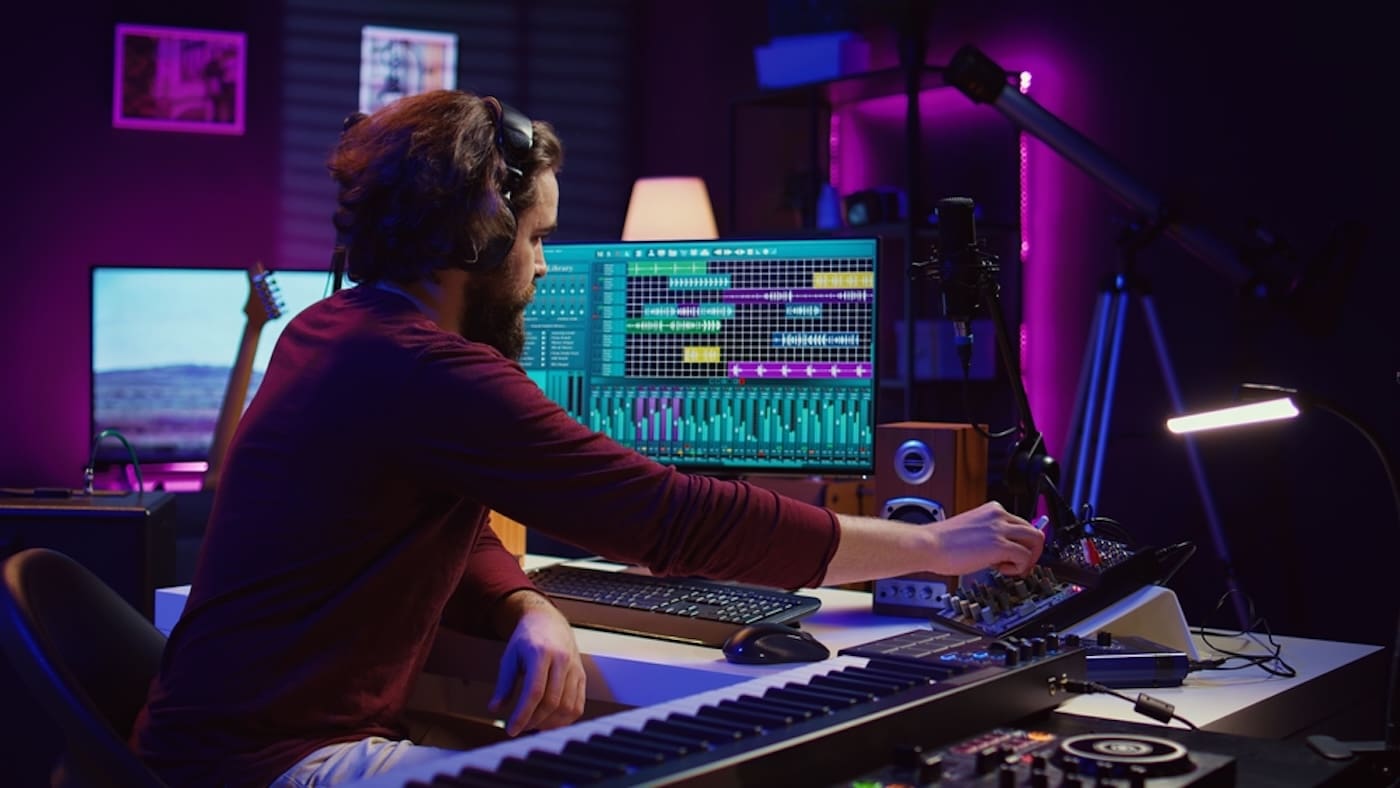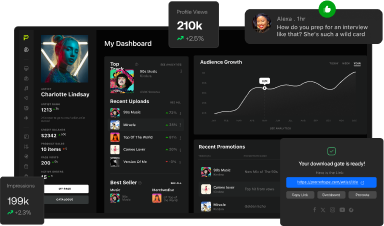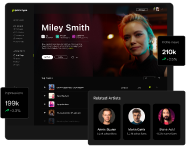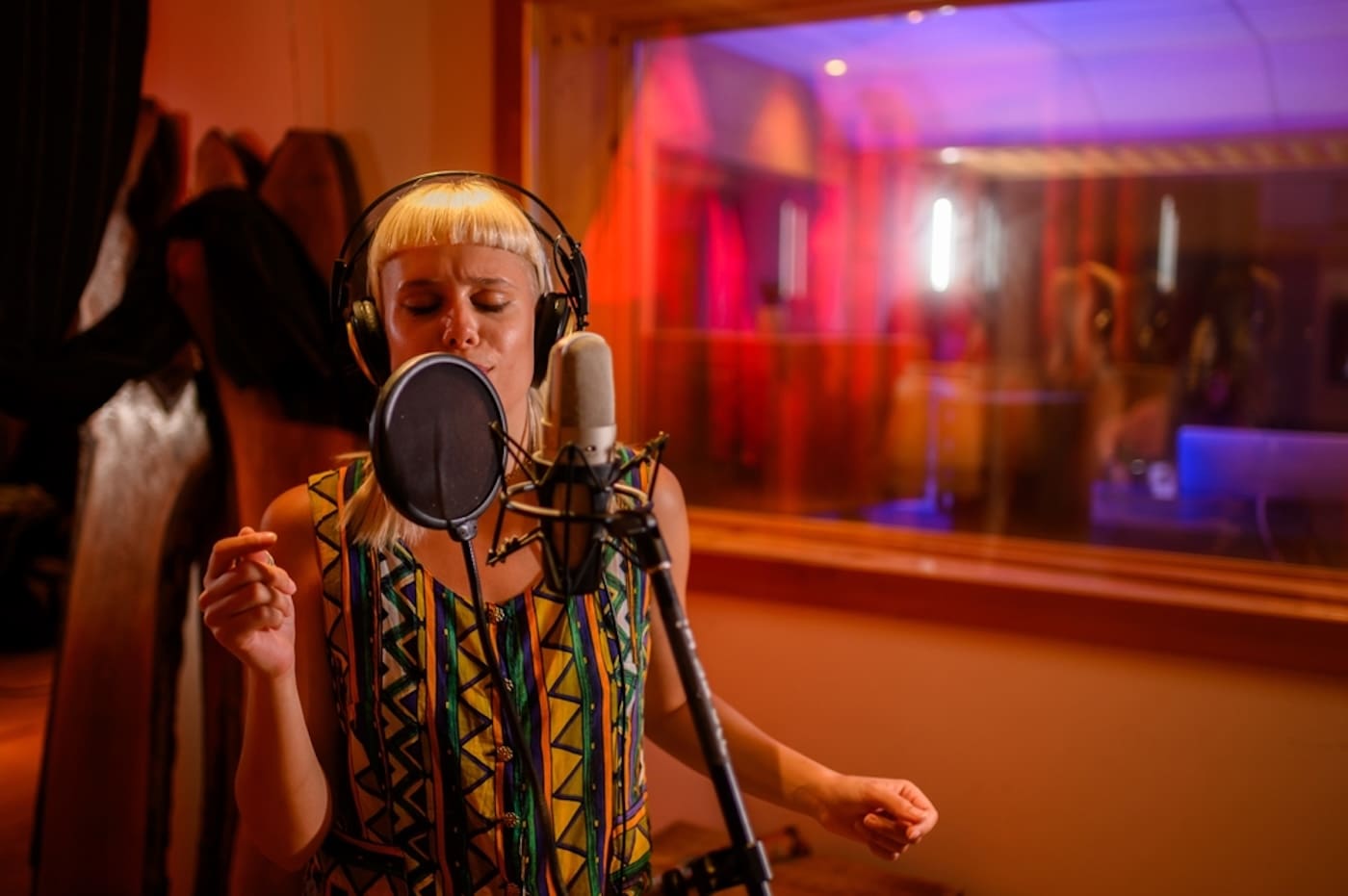
Producing great music requires balancing individual instruments and adjusting their qualities to ensure the final mix sounds professional and polished.
The difference between mixing and mastering drives music production, with mixing applied to individual tracks and mastering to the final mix.
Continue reading for a comprehensive breakdown of mixing and mastering, as well as their essential roles in the production process.
Get Early Access
To Promo Hype
What Is The Mixing Process?
The mixing process is a core aspect of learning how to make music for all genres that sounds polished and professional.
It involves taking the various individual tracks that are combined in a song, making specific adjustments to enhance their impact.
Vocals, instruments, drums, and other percussive elements are addressed individually, from adjusting gain to tweaking EQ settings.
This process ensures multiple tracks don’t clash and unwanted low-frequency hums and other distractions are removed.
These edits are performed through mixing essentials, such as EQ and effects VST plugins or their hardware counterparts.
Sound Selection & Recording
Before you can begin the mixing stage, you need to gather your audio sources to use in the production.
This can involve recording vocalists and instruments in a home recording studio or using professional recording engineer services.
Alternatively, it can require the acquisition of sample packs and other resources, such as free instrumental tracks from famous artists.
Each of these assets should be saved using an intuitive naming convention system to ensure everything is easy to find.
This can help with managing large projects that involve dozens of individual tracks, each requiring a dedicated channel in your DAW.
Read more: Explore Promo Hype’s music distribution services.
Gain & Levels
Once the individual tracks are loaded into the DAW, you’re ready to adjust the gain to ensure everything sounds great.
All music production software includes faders to control levels, accompanied by a red bar that indicates when tracks are clipping.
You can use these visual indicators to assess each song element, boosting the gain on quieter elements and adjusting other settings accordingly.
Panning & Equalization
With the gain staging complete, the next stage in the mixing process is panning and equalization of the individual elements.
Panning can be used to balance out the soundstage, while EQing ensures each element is carved out in a given frequency range.
You can enhance certain elements and track levels using filters, which offer low and high-pass filter options for drums and instruments.
Reverb, Delay & Other Effects
The best DAWs include extensive selections of effects to elevate your mixes, with reverb and delay being the most commonly used.
These effects bring additional creativity to the mixing process and can be applied to individual elements or groups of sounds.
It’s here where the song’s sense of personality can be forged, whether it’s rugged and atmospheric or a lush, mellow vibe.
Saturation, distortion, and modulation are additional effects that add texture and character, defining an artist’s unique vision.
Automating Parameters
The mixing stage also involves automating various parameters to apply adaptive effects over time.
This allows producers to create fluid and dynamic changes to elements, such as shifting the velocity of volume or effects.
These adjustments can be made in real-time using a MIDI controller to record parameter changes using knobs or sliders.
Must read: Learn how to read sheet music.
What Is The Mastering Process?
If the mixing process can be viewed in the macro sense by addressing all of a song’s tracks, mastering focuses on the final mix.
A separate process from mixing, a mastering engineer addresses the completed stereo track across the entire song.
Serving as the quality control for the final sound, mastering incorporates a selection of tools to optimize it for various playback systems.
This includes various types of speakers and headphones, as well as optimization for streaming on major music platforms.
It’s an essential process for anyone considering submitting music to radio stations or record labels, where professionalism is a must.
Loudness Optimization
Optimizing the loudness of a song is a core process in mastering, whether using a DAW or dedicated AI-based mastering tools for indie artists.
This addresses peaks and troughs in loudness that occur throughout a song’s structure, using EQing and limiters across the stereo track.
Linear-phase EQs are often preferred for mastering, as they maintain phase relationships across the frequency spectrum.
This allows the producer to make subtle adjustments while still preserving the integrity of the song’s overall sound.
Applying Compression
Another core role of the mastering engineer is applying audio compression, which controls a song’s dynamic range.
It’s here where the track sound becomes more impactful, with compression adding significant punch and presence across the mix.
This is achieved by establishing a ratio control signal reduction above a specified threshold and applying makeup gain where necessary.
Attack and release controls refine the application of compression to prevent cutting off transients at the start of drum hits, ensuring a smoother sound.
When using compression, consider your style of music beforehand, as different compression tools deliver various results.
For bands, the Waves Abbey Road TG Mastering Chain is a popular option, while the FabFilter Pro-L 2 is excellent for electronic music.
Get Early Access
To Promo Hype
Using Limiters
Limiters, whether hardware-based or VST plugins, augment the function of compression to further increase volume.
They perform this task with an approach that controls audio signal peaks to prevent clipping, allowing levels to be pushed to the limit.
In addition to maximizing loudness and preventing clipping, limiters can also control transients to prevent them from exceeding the threshold.
Typically used as the final effect in the mastering stage, limiters sometimes include oversampling and peak detection features.
Recommended read: The 10 best music producers of all time.
Mixing vs. Mastering: Key Differences
While mixing and mastering share similar tools and desired outcomes, there are some crucial differences to be aware of.
Here are some factors that distinguish mixing and mastering in a production workflow:
- Position in the overall production workflow: The mixing process is initiated immediately following the recording session, with producers working on tracks to mix sound elements throughout the entire project. Conversely, mastering occurs in the final stage once a stereo file has been exported for the mastering engineer.
- Focus on individual tracks and the entire track: Mixing is designed to reshape individual tracks, applying EQ and gain staging along with effects to drums, vocals, and other elements. For mastering, a single audio file is used for the entire song, shaping the overall track sound to enhance dynamic range with subtle broad strokes.
- Audio standardization: While the mixing process addresses balancing individual instruments, mastering is designed to enhance perceived loudness. This ensures the music sounds professional on stereos and other formats, meeting industry-standard levels and making it ready for public consumption.
Both processes lie at the heart of what music producers do to ensure individual elements are balanced and avoid creating a poor mix.
Ultimate Resources For Mixing And Mastering
With thousands of professional producers and many more hobbyists, there’s no shortage of resources for music production tips.
This includes mixing and mastering, whether you’re using basic software or working with a recording engineer in a studio.
If you’re struggling with the process or want to expand your skillset, check out these mixing and mastering resources:
- YouTube music production channels: There are hundreds of YouTube channels dedicated to various aspects of music production, offering hours of free content. You can use these to learn the mixing stage or fine-tune the mastering stage at your own pace.
- Free and paid online music production courses: For those seeking a personalized learning experience, many online music production courses offer access to instructors. You can find free online courses for a basic overview or pay for more in-depth courses on mixing and mastering.
- Music blogs and websites: If you prefer to read through instructions and tutorials instead of watching videos, you can search for music blogs and websites. Many of these feature comprehensive guides with visual aids to help with the overall learning process.
- Dedicated music production books: For a truly detailed overview and in-depth exploration of music production, dedicated books are available to help. Many of these are written by former music industry professionals with first-hand knowledge of working in a studio.
- Music production schools: The most hands-on method for learning mixing and mastering is attending a music production school. The best music production schools will help you become a qualified mixing engineer with the credentials to enter the industry.
You can also learn about related concepts, such as music theory, that can help improve your overall sound and understanding of production.
Discover more about Promo Hype membership.
Essential Equipment For Mixing And Mastering
If you’re learning how to become a music producer, you’ll need to ensure you have the necessary equipment for various processes.
While the professional mastering engineer typically uses a dedicated mixing desk, you can achieve great results using software.
Here’s a quick overview of the core gear needed for mixing and mastering songs to ensure everything sounds good:
- Computer with a digital audio workstation (DAW): While some producers emphasize the use of hardware in their studio, many utilize digital audio workstations to mix and master their music. Ensure your computer’s specifications meet DAW requirements to avoid lag and other issues when producing music.
- Audio plugins: Audio plugins offer digital alternatives to hardware, encompassing compressors, reverb, chorus, and other effects. You can save money by browsing through the best free VST plugins, which also include hundreds of virtual instruments.
- MIDI controller interface: While it is possible to edit your parameters using a mouse and keyboard, the process can become cumbersome quickly. Using a MIDI controller will enable you to map these parameters to knobs and sliders, streamlining your workflow.
- Audio interface: If you’re involved in the recording process or using physical effects, an audio interface is necessary to connect your equipment to your computer. For larger recordings, such as with bands, higher-end audio interfaces offer more inputs and greater control.
- Headphones/monitor speakers: Monitoring audio levels and the impact of effects requires a solid, even response pair of headphones or speakers. The best studio headphones make it easier to discern subtle distinctions between sounds, allowing for optimal balancing.
Additionally, you can add a microphone if you’re participating in the recording process and use it for vocals and samples.
Showcase & Promote Your Music With Promo Hype
Mixing and mastering music is a lengthy process, but the high-quality final sound makes the effort worthwhile.
Once your tracks are ready, they deserve to reach the largest audience possible on the major music streaming platforms.
By becoming a Promo Hype member, you can build your artist brand with the following services:
- Comprehensive distribution on all streaming platforms: The online music streaming landscape is fragmented across multiple competing platforms used by music lovers. Promo Hype ensures your latest releases are launched simultaneously on Spotify, Apple Music, TIDAL, and other platforms.
- Robust tools to promote your music worldwide: The music industry is highly competitive, requiring well-considered promotional campaigns to capture the attention of listeners. With Promo Hype’s Promotional Toolkit, you can drive your music to platforms that deliver the highest engagement.
- In-depth analytics to help you grow your brand: Understanding the demographics and online behaviors of fans is vital for developing a brand. You can use Promo Hype’s dashboard to access a range of metrics and analytical tools.
- A thriving community for like-minded independent artists: Connecting with successful independent artists can lead to fruitful collaborations and more exposure. Promo Hype’s dedicated Community is available to learn about the mixing process and connect with musicians.
With a personalized dashboard and other resources, Promo Hype is an essential platform for distributing the most popular music genres.
Summary
Mixing and mastering are foundational for producing music, whether working with recorded instruments or creating electronic music.
The core processes outlined in this guide ensure quality control throughout the entire mix, delivering exceptional results.
Once you’re satisfied with your music, you can offer mixing and mastering services to other artists and bands in your circle.
Get Early Access
To Promo Hype
Join Promo Hype






